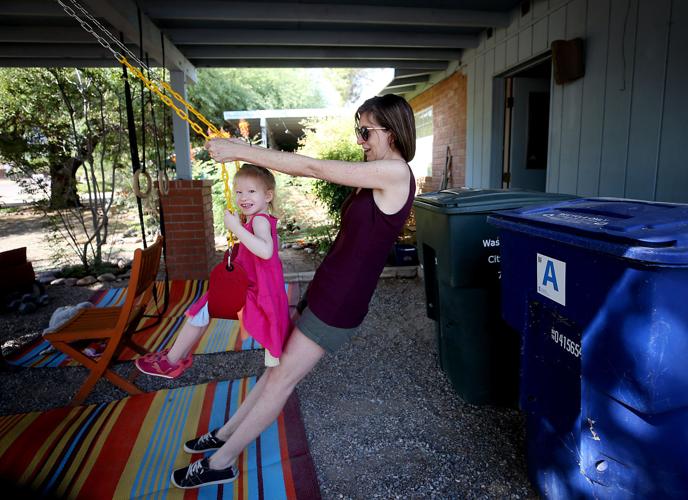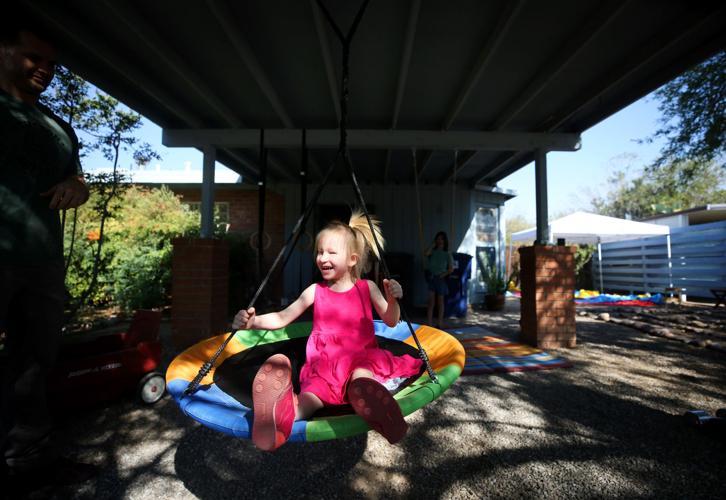Getting a doctor’s advice or a therapist’s help without risking infection from a face-to-face visit to a medical office has been essential for many Tucson residents during the pandemic.
Now, with Arizona’s rate of infection still rising and no vaccine in sight, many are wondering how long insurance providers will keep covering the video visits and telephone calls commonly referred to as telemedicine or telehealth.
The uncertainty is troubling for Tucson mothers like Sara Nixon-Kirschner and Dianne Westfall, whose young children have challenges that require medical care and therapies while also making them especially vulnerable to viruses and infection.
Nor is it comforting for Tucson residents like Melinda Parris, whose immune system has been weakened by cancer treatments. She needs pain medication but can’t renew her 30-day prescription without an in-person visit, which is especially frustrating after being able to use video appointments for pain medications in April.
“My nephrologist and my pulmonologist are still available by telehealth, my primary care is not offering it, nor is my oncologist,” she said. “So, it’s hit or miss, and I’m taking what I can get.”
On Friday, Parris saw a notice on an insurance form that telemedicine might not be covered anymore, so she started investigating.
“My doctor says call Medicare, who said to call Humana, who said as far as they can tell it’s covered,” she said Friday. “When I pressed for a coverage date, the person I spoke to said she doesn’t see any date so she assumes it’s Dec. 31, 2020.”
That date is better than what people were hearing earlier this month, when many were bracing for telemedicine visits to end at the end of June or sometime in July.
But as of last week, with the coronavirus continuing to make people afraid to keep in-person appointments, many providers announced telemedicine will continue until the end of September.
“Cigna has no plans to end coverage for telehealth,” said Mark Slitt, public relations senior advisor for the company. “In fact, we have been expanding telehealth coverage to include behavioral health and dental care, and we have been collaborating with a variety of virtual providers nationally and in specific states.”
Aetna and United Healthcare, two more examples, have extended their coverage of telemedicine appointments through the end of September.
“Right there at my fingertips”
Continuing coverage is good news for Tucsonan Amy Burke, who has counted on telemedicine to help her with the post-traumatic stress she developed while working as respiratory therapist in Brooklyn for the first two months of the pandemic. Burke now has daily panic attacks.
Burke said she can text her therapist at any time and also has an hourlong phone or video session each week.
“I love that I can have therapy whenever I need it,” she said. “It’s right there at my fingertips.”
Typically, payment for a telemedicine visit is lower than an in-person visit and was not offered as readily because of regulations imposed by the Centers for Medicare & Medicaid Services, or CMS. That’s changed to equal coverage for both in-person and video appointments due to the pandemic.
“I would argue it should continue in perpetuity,” said Dr. Jeff Couchman, a local pediatrician. “As for private insurers, CMS payment policies don’t necessarily translate over to private insurers — they can essentially pay however they want, but they usually follow CMS.”
Around the country, there have been a variety of challenges related to telemedicine, said Dr. Jacqueline W. Fincher, president of the American College of Physicians. Some elderly patients, for example, are not very tech savvy and may not have the iPad or computer they need.
“In the rural areas, broadband is a major issue,” Fincher said. “So even if patients do have a smartphone and can receive the telemedicine platform link, when they hit the link, there’s not enough bandwidth to download the link.”
And while many of the private insurers offer payment parity for telemedicine, it’s limited to video visits and not necessarily telephone only — which is what some elderly patients want.
“The ACP is pushing both CMS and AHIP, or America’s Health Insurance Plans, to continue paying physicians to do telemedicine and telephone visits with their patients appropriately based on the patients’ needs and delivering patient care whatever way the patient and the physician think is best,” Fincher said. “That should not be determined by geography, especially when transportation can be an enormous barrier to getting the care needed face to face.”
The option has also been helpful for physicians who collect a fee for service, as it’s enabled them to stay open and still see patients despite the pandemic.
Fincher’s organization is pushing for continued pay parity for telemedicine and face-to-face visits until at least the end of 2021.
“That’s because the COVID-19 virus will continue to have major impact on patients and physicians ability to have face-to-face visits as the virus waxes and wanes over the next 18 months,” she said.
“Until we have an effective vaccine that is widely distributed and taken by the public and effective treatment if one gets COVID, then we will still be stuck with social distancing, masks and limited face-to-face visits, especially for routine, chronic or preventive visits.”
“Not as efficient”
Tucson providers like Dr. Jane Hartline of El Sol Family Medicine, 2260 N Rosemont Blvd., have been using telemedicine since shortly after the pandemic started.
“My patients really appreciate that they don’t have to leave their homes, to be able to meet with their physician and not have to take the risk,” she said.
She encourages people who want to see this choice continue to reach out to insurers and make that known.
Couchman said since the pandemic began anyone who calls in sick to Mesquite Pediatrics, 2350 N. Kibler Place, No. 1, can start with a telemedicine appointment and then, if it’s needed, comes into the office.
Theoretically, it costs less, he said, since there are no gloves, paper, nursing or staff time.
On the other hand, appointments take about twice as much time because there can be connectivity issues, illnesses can take longer to diagnose and then there are patients who have to come into the office anyway .
“Telemedicine is not as efficient,” he said. “I can’t schedule as many patients in a day.”
Intermountain Centers for Human Development are now using telemedicine for about 80% to 85% of its appointments, said Paul O’Rourke, a spokesman.
“If our (COVID-19) numbers are like they are now, there’s no reason for them not to continue these services,” he said of providers. “People will be afraid to come to a health center.”
For Intermountain’s low-income patients, using up a lot of phone data can be tough, said Jessica Reese, chief clinical officer for Intermountain. To help, the centers are trying to utilize grants to provide phone cards.
“We do have a lot of individuals living below the poverty line and we really need to be thinking about equal access to care,” she said. “We are getting innovative about how to provide this to our members.”
For mothers Westfall and Nixon-Kirschner, telemedicine means keeping their children both safe and cared for during the pandemic.
Westfall’s 3-year-old daughter, Maddie, has a rare chromosomal disorder called Cri du Chat Syndrome that made them nervous about infection even before COVID-19. “We’ve always acted like flu season was a pandemic,” she said. “We self-isolate and wear masks every year.”
For Nixon-Kirschner, continuing to get speech therapy for 4-year-old daughter Rosie has been critical as they help her with a genetic disorder called Koolen-de Vries syndrome.
“We would love to be in the same room as our therapist and Rosie loves the stimulation of being together,” she said of her daughter’s speech therapist at Tucson’s Mealtime Connections, 1601 N. Tucson Blvd. But since that’s not possible, she said, she is very grateful for telehealth.
“If they were to turn it off,” she said, “I don’t know what we would do.”
Photos for May 29: Tucson gets by during Coronavirus Pandemic
Tucson gets by during coronavirus pandemic
Updated
The iconic Casa Molina bull and matador statue both sport masks on the first full week of the loosening of COVID19 restrictions, May 23, 2020, Tucson, Ariz. The bull previously had a mask on the testicles.
Tucson gets by during coronavirus pandemic
Updated
Michelle Leon Cordova, right, mother, and her son Sahuarita High School senior Lino Cordova, whom is fighting cancer, wave at staff members from Diamonds Children Center, friends and the Marana Police Department during a car parade, celebrating Lino's graduation, outside of his home on May 13, 2020 in Sahuarita, Ariz. Cordova stood on the sidewalk while the team from Diamond Children Center, friends and the Marana police department gave Cordova a graduation gar parade. Cordova was given a gift basket with his favorite snacks, gift cards as well as other items he enjoys. The car parade, also, celebrated another graduating senior fighting cancer from Empire High School, Noah Nieto. Nieto, also, received a gift basket with snacks, gift cards and other items Lino enjoys.
Tucson gets by during coronavirus pandemic
Updated
Michelle Leon Cordova, right, mother, brings celebration balloons to a car after staff members from Diamonds Children Center, friends and the Marana Police Department celebrate Sahuarita High School senior Lino Cordova, whom is fighting cancer, graduation with a car parade outside of his home on May 13, 2020 in Sahuarita, Ariz. Cordova stood on the sidewalk while the team from Diamond Children Center, friends and the Marana police department gave Cordova a graduation gar parade. Cordova was given a gift basket with his favorite snacks, gift cards as well as other items he enjoys. The car parade, also, celebrated another graduating senior fighting cancer from Empire High School, Noah Nieto. Nieto, also, received a gift basket with snacks, gift cards and other items Lino enjoys.
Tucson gets by during coronavirus pandemic
Updated
Personnel from Tucson Medical Center line the heliport to watch A-10's from Davis-Monthan Air Force Base's 355th Wing and F-16's from the Arizona Air National Guard's 162nd Wing make a pass over the facility, one leg of an area wide community flyover, May 14, 2020, Tucson, Ariz.
Tucson gets by during coronavirus pandemic
Updated
Nancy Celix-Campos, right, a respitory therapist at Tucson Medical Center, watches the military flyover with her daughters, Giana, 12, and Jazmyn, 8, from Sentinel Peak on May 14, 2020. Two F-16 Fighting Falcons from Arizona Air National GuardÕs 162nd Wing and two A-10 Thunderbolt II's from the 355th Wing, assigned to Davis-Monthan Air Force Base, fly over Tucson area hospitals to honor healthcare personnel and first responders as they are some of the frontline workers dealing with the coronavirus disease (COVID-19) head on. "It's been an exhausting two to three months," says Campos, "it's pretty cool, I like how they're going by each hospital."
Tucson gets by during coronavirus pandemic
Updated
Two F-16 Fighting Falcons from Arizona Air National Guard’s 162nd Wing and two A-10 Thunderbolt II's from the 355th Wing, assigned to Davis-Monthan Air Force Base, fly over Northwest Medical Center north of Tucson on May 14, 2020.
Tucson gets by during coronavirus pandemic
Updated
A letter carrier portrait on the Ok Market building, located in the Armory Park neighborhood, is adorned with a face mask on May 18, 2020.
Tucson gets by during coronavirus pandemic
Updated
Rosemary Garcia waits for a family member outside of a store at Park Place Mall, 5870 E. Broadway Blvd., in Tucson, Ariz. on May 19, 2020. Malls reopened today under CDC guidelines and Gov. Ducey's new rules for businesses due to the Coronavirus pandemic. Park Place Mall has signs throughout the mall reminding customers to keep a six feet distance as well as hand sanitizer stations near each entrance. About half of the tables in the food court have been removed to allow for social distances as well as less than half of the stores have opened with new guidelines. Of the stores open, only 10 customers are allowed to shop in each store at a time.
Tucson gets by during coronavirus pandemic
Updated
Pat Schlote steams clothing before it is put on the sales floor at the Golden Goose Thrift Shop in Catalina, Ariz., on May 21, 2020.
Tucson gets by during coronavirus pandemic
Updated
Ada Contreras, teaching assistant, looks through containers while reorganizing toys at Herencia Guadalupana Lab School, 6740 S. in Tucson, Ariz. on May 21, 2020. As Child care centers begin to re-open when they are ready, Herencia Guadalupana Lab School is reorganizing and cleaning everything in the facility before re-opening on June 2. To allow for social distancing and decrease the amount of items children touch, Herencia Guadalupana Lab School has sheds where items will go as well as placing items in containers organized by category.
Tucson gets by during coronavirus pandemic
Updated
Jen Martinez, right, softball coach, teaches Skylar Reilly about hitting during a session at Centerfield Baseball Academy, 5120 S. Julian Dr., in Tucson, Ariz. on May 21, 2020. After re-opening on Monday, Centerfield Baseball Academy has implemented new policies in response to the Coronavirus Pandemic such as wearing masks, cleaning, signage, hand sanitizer and limiting the amount of people inside the facility.
Tucson gets by during coronavirus pandemic
Updated
Karl Bosma, left, and George Cantua, with facilities and maintenance, lay down stickers to mark six-foot separation distance around one of the baggage carousels, part of the efforts at Tucson International Airport to work within the restrictions of COVID19, May 22, 2020, Tucson, Ariz.
Tucson gets by during coronavirus pandemic
Updated
A lone passenger waits for a flight near one of the shuttered restaurants in the B Gates before Memorial Day at Tucson International Airport on May 22, 2020.
Tucson gets by during coronavirus pandemic
Updated
Drew Cooper on the stage in the St. Philip's Plaza courtyard, May 22, 2020, Tucson, Ariz., where live music is back on the schedule.
Tucson gets by during coronavirus pandemic
Updated
Many people visit Tumamoc Hill during the first day of Tumamoc's re-opening in Tucson, Ariz. on May 25, 2020. After being closed due to the Coronavirus pandemic, Tumamoc Hill re-opened with some modifications. There are hand sanitizer stations throughout the hike to the top as well as arrows, spaced 10-ft apart, lined up and down the hill. Some runners, hikers and walkers are also wearing masks during their hike. "The steps we are taking aim to provide our community with needed exercise, connection to our beautiful desert and a sense of comfort in such a trying time, while balancing the fact that gathering as a community endangers each of us and our loved ones. This is an unprecedented challenge that we are taking extremely seriously," said Benjamin T. Wilder, director of Tumamoc Hill. Visitors are also asked to limit their group to three people and to not touch the gate at the top of the hill- a tradition for some who make it to the top. "This is a time when we need to establish new traditions and adapt in a creative manner that embraces empathy, unity, care and patience," Wilder said.
Tucson gets by during coronavirus pandemic
Updated
Pen Macias, artist, works on part 2 of a mural for a client on E. Broadway Rd., between S. Columbus Blvd. and S. Alvernon Way, in Tucson, Ariz. on May 25, 2020. Macias, known as The Desert Pen, has been working on her clients mural for the past three months. "It's the one thing I love, I have a passion for and the only thing I could be happy doing," said Macias. The mural represents her client, a single mother of four who works in the health care field. One half of the mural is dedicated to the connection between mothers and their children. The other half is dedicated to the connection between nurses and patients. The client wanted some positivity in the mural to show how nurses give a piece of themselves to their patients hence the puzzle pieces in the nurse and the patients, said Macias.
Tucson gets by during coronavirus pandemic
Updated
Christina Cortinas, posing at her home, May 28, 2020, Tucson, Ariz., with a photo of her and her mother, Catherine Rodriguez, in San Diego, 1991. Rodriguez is currently in assisted living and fighting COVID19. Cortinas hasn't seen her mother in months, the longest such span in her life.
Tucson gets by during coronavirus pandemic
Updated
Ruben Lopez looks through handouts while attending a Eviction Resource Fair with his family outside the Pima County Justice Court.





